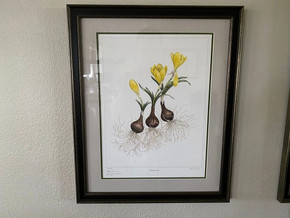
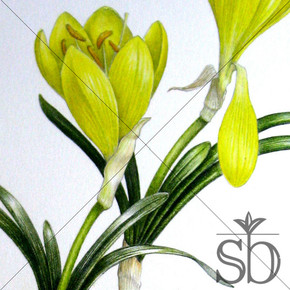
One of my favorite stories about this bulb, is from a time that I was presenting at a convention to an international flower bulb group in San Antonio by The Riverwalk. This group had bulb growers and exporters from around the world, including Israel! As I droned on and on about how old and historic our bulbs are that we find on the old abandoned homesites in the Southern United States, they politely listened. When I showed pictures of this Sternbergia, they perked up! After some chatter, one raised his hand and I called on him.
He said “You have been talking about old bulbs. Now THIS is an old bulb. We have seen this bulb on ancient Babylonian sites!”
I didn’t know what to say. I had been talking about perennial bulbs that grow in our garden for 100s of years. He just mentioned sites where the bulbs have been around for 1,000s of years. “Yes,” I said. “That is old.” Everyone had a good laugh.
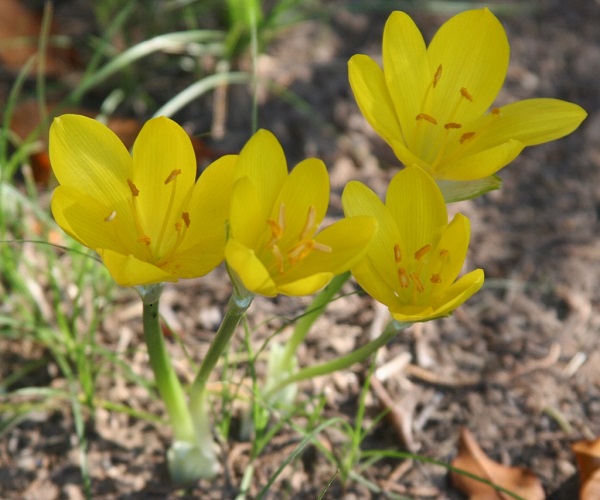
Names: You may have heard about the Sternbergia lutea from your parents or grandparents. However, they may have called her....yellow autumn crocus, winter daffodil, Mt. Etna lily, buttercups, or even the Lily of the Field. This flower bulb evokes many different names because of the impact it has on so many gardeners as the bold yellow surprises them each fall. A native of Greece, it is one of the first flower bulbs grown in America.
Is this a daffodil? No, it's not. You probably already noticed that the genus name is Sternbergia and not Narcissus. However, they are both from the Amaryllis family so they have several familiar traits especially how they look. However, this lovely “Autumn Daffodil” acts more like its cousins the red and yellow spider lilies, who are also part of the Amaryllis family. We completely agree that it looks a lot like a crocus when it first opens up but the crocus belongs to the iris family so technically they aren't even cousins.

Where have we seen it? Usually this time of year we see many of these blooming from Dallas to the west of Fort Worth and all the way down to Austin. It seems to prefer these clay and rocky soils where they can dry out in the summer. However, it also doesn't seem to mind the nice sandy loam soils of our farm, but we don't see much of it on the old home sites across East Texas.
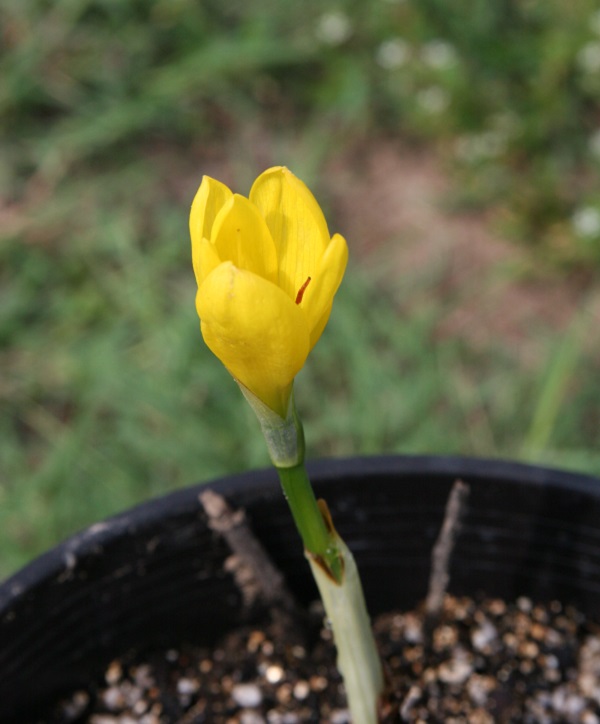
The bloom when it first begins to open is cup shaped like the crocus.
What to expect: You might see the foliage this January-May, but don't be concerned if you don't. The foliage dies down with the first warm weather in the spring. Most people still expect to see something growing during the summer months. You won't see anything. These bulbs are completely dormant in the summer. The flowers suddenly appear with the September rains. One day there is nothing growing and then suddenly you have a surprise, a fully blooming flower! These lovely little blooms act very similar to red spider lilies, yellow spider lilies, schoolhouse lilies, and naked ladies. Simply put, you won't see anything growing, then they suddenly bloom in the fall, and then they have foliage for the winter. Think of it this way, you will never see a Sternbergia bloom with full green foliage. The bloom always sits on a naked stalk , with possibly some fresh foliage just beginning to appear at the base.
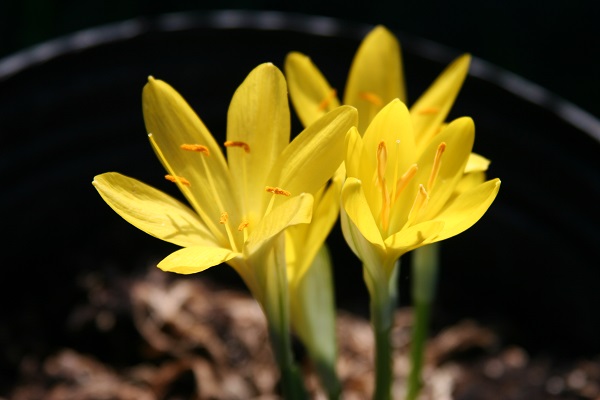
Later the blooms open wide to present all their color and glory like the Narcissus.
Care and planting: The Sternbergia lutea acts so much like the Lycoris that you are going to think that you just read some of this last week, and you would be right.
Zones: These bulbs do best in zones 7-9. Because they need winter sun, they really don't do well in colder zones. Hard freezes in Zone 7 and down can be damaging.
Soil: As mentioned above, this bulb does great planted in clay, rocky, or sandy soil. It likes well-drained soil so you may even consider a slightly raised bed. If you are going to plant this in a pot, be sure that the pot has good drainage, but really they are meant for the garden and to be in the ground..

Sun: This is the most important part in the care and planting of the Sternbergia bulbs! Because the foliage appears AFTER the bloom, you need to be concerned with the winter sun. The foliage needs at least 1/2 day of winter sun. Since we are concerned with the winter, consider more sun rather than less. You know how quickly good sunshine can melt a little bit of snow that falls in February whereas in the shade the snow seems to linger. When you look at the pictures, you notice that the blooms appear in everything from full sun to almost full shade. That's because the blooms, which appear in September, don't take in the nutrients so you can plant them under deciduous trees like live oaks or pecans where the bulbs can collect all of the winter sun they need.
Blooms: In September, after the fall rains begin, little bursts of sunshine will pop out of the ground on naked stalks. Their bloom is only 4-6" tall, but they will draw one's eyes with their bright yellow color when most bulbs are no longer blooming. The blooms will look like little crocus cups at first, and then they will open their petals wide to cover 2-3 inches. The bulbs bloom for a couple of weeks.
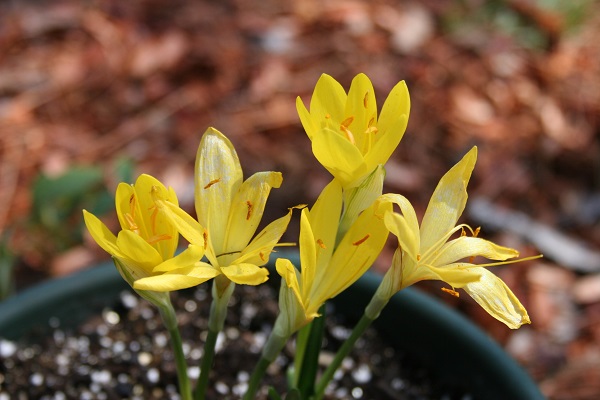
After the blooms: After the blooms die back, little tufts of foliage appear. The foliage often reminds people of "monkey grass," but be sure not to cut it as the bulb needs the nutrients that the foliage provides to get it through the summer. The foliage will die back around the beginning of May with the first warm weather of the year. Then the bulb is dormant until you see the bloom the next September.
Plant and Water: Plant the bulbs with about 4-5 inches of soil above them. You might also plant the bulbs about 4 inches apart. Make sure that your bulbs don't get too much summer water. They like to be dry during the summer.
Animals: Like the other bulbs in the Amaryllis family, these bulbs and foliage are resistant to deer and other animals, but deer and rabbits will eat the flowers occasionally.
It is a popular bulb for rock gardens with its low blooming habit and foliage that stays fairly well maintained. The 'Sternbergia' enjoys good drainage and slightly gravelly soil. Some areas where it can be found naturalized would be the heavy black land soils that tend to dry out and crack during the summer months. It has performed well for the Southern Bulb Company in slightly acidic sandy loam to slightly alkaline clay soils. For some, the yellow crocus-like bloom it produces in the fall is the closest they will ever come to a crocus in their garden.
One of my favorite stories about this bulb, is from a time that I was presenting at a convention to an international flower bulb group in San Antonio by The Riverwalk. This group had bulb growers and exporters from around the world, including Israel! As I droned on and on about how old and historic our bulbs are that we find on the old abandoned homesites in the Southern United States, they politely listened. When I showed pictures of this Sternbergia, they perked up! After some chatter, one raised his hand and I called on him.
He said “You have been talking about old bulbs. Now THIS is an old bulb. We have seen this bulb on ancient Babylonian sites!”
I didn’t know what to say. I had been talking about perennial bulbs that grow in our garden for 100s of years. He just mentioned sites where the bulbs have been around for 1,000s of years. “Yes,” I said. “That is old.” Everyone had a good laugh.

Names: You may have heard about the Sternbergia lutea from your parents or grandparents. However, they may have called her....yellow autumn crocus, winter daffodil, Mt. Etna lily, buttercups, or even the Lily of the Field. This flower bulb evokes many different names because of the impact it has on so many gardeners as the bold yellow surprises them each fall. A native of Greece, it is one of the first flower bulbs grown in America.
Is this a daffodil? No, it's not. You probably already noticed that the genus name is Sternbergia and not Narcissus. However, they are both from the Amaryllis family so they have several familiar traits especially how they look. However, this lovely “Autumn Daffodil” acts more like its cousins the red and yellow spider lilies, who are also part of the Amaryllis family. We completely agree that it looks a lot like a crocus when it first opens up but the crocus belongs to the iris family so technically they aren't even cousins.

Where have we seen it? Usually this time of year we see many of these blooming from Dallas to the west of Fort Worth and all the way down to Austin. It seems to prefer these clay and rocky soils where they can dry out in the summer. However, it also doesn't seem to mind the nice sandy loam soils of our farm, but we don't see much of it on the old home sites across East Texas.

The bloom when it first begins to open is cup shaped like the crocus.
What to expect: You might see the foliage this January-May, but don't be concerned if you don't. The foliage dies down with the first warm weather in the spring. Most people still expect to see something growing during the summer months. You won't see anything. These bulbs are completely dormant in the summer. The flowers suddenly appear with the September rains. One day there is nothing growing and then suddenly you have a surprise, a fully blooming flower! These lovely little blooms act very similar to red spider lilies, yellow spider lilies, schoolhouse lilies, and naked ladies. Simply put, you won't see anything growing, then they suddenly bloom in the fall, and then they have foliage for the winter. Think of it this way, you will never see a Sternbergia bloom with full green foliage. The bloom always sits on a naked stalk , with possibly some fresh foliage just beginning to appear at the base.

Later the blooms open wide to present all their color and glory like the Narcissus.
Care and planting: The Sternbergia lutea acts so much like the Lycoris that you are going to think that you just read some of this last week, and you would be right.
Zones: These bulbs do best in zones 7-9. Because they need winter sun, they really don't do well in colder zones. Hard freezes in Zone 7 and down can be damaging.
Soil: As mentioned above, this bulb does great planted in clay, rocky, or sandy soil. It likes well-drained soil so you may even consider a slightly raised bed. If you are going to plant this in a pot, be sure that the pot has good drainage, but really they are meant for the garden and to be in the ground..

Sun: This is the most important part in the care and planting of the Sternbergia bulbs! Because the foliage appears AFTER the bloom, you need to be concerned with the winter sun. The foliage needs at least 1/2 day of winter sun. Since we are concerned with the winter, consider more sun rather than less. You know how quickly good sunshine can melt a little bit of snow that falls in February whereas in the shade the snow seems to linger. When you look at the pictures, you notice that the blooms appear in everything from full sun to almost full shade. That's because the blooms, which appear in September, don't take in the nutrients so you can plant them under deciduous trees like live oaks or pecans where the bulbs can collect all of the winter sun they need.
Blooms: In September, after the fall rains begin, little bursts of sunshine will pop out of the ground on naked stalks. Their bloom is only 4-6" tall, but they will draw one's eyes with their bright yellow color when most bulbs are no longer blooming. The blooms will look like little crocus cups at first, and then they will open their petals wide to cover 2-3 inches. The bulbs bloom for a couple of weeks.

After the blooms: After the blooms die back, little tufts of foliage appear. The foliage often reminds people of "monkey grass," but be sure not to cut it as the bulb needs the nutrients that the foliage provides to get it through the summer. The foliage will die back around the beginning of May with the first warm weather of the year. Then the bulb is dormant until you see the bloom the next September.
Plant and Water: Plant the bulbs with about 4-5 inches of soil above them. You might also plant the bulbs about 4 inches apart. Make sure that your bulbs don't get too much summer water. They like to be dry during the summer.
Animals: Like the other bulbs in the Amaryllis family, these bulbs and foliage are resistant to deer and other animals, but deer and rabbits will eat the flowers occasionally.
It is a popular bulb for rock gardens with its low blooming habit and foliage that stays fairly well maintained. The 'Sternbergia' enjoys good drainage and slightly gravelly soil. Some areas where it can be found naturalized would be the heavy black land soils that tend to dry out and crack during the summer months. It has performed well for the Southern Bulb Company in slightly acidic sandy loam to slightly alkaline clay soils. For some, the yellow crocus-like bloom it produces in the fall is the closest they will ever come to a crocus in their garden.